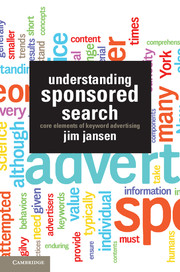Book contents
- Frontmatter
- Contents
- Preface
- Acknowledgments
- Notes on Terminology
- 1 A Context for Sponsored Search
- 2 Modeling the Process of Sponsored Search
- 3 Understanding Customer Intent for Keyphrase Selection
- 4 Sending Signals to the Customer with Ads
- 5 Understanding Consumer Behavior for Sponsored Search
- 6 BAM!: Branding, Advertising, and Marketing for Sponsored Search
- 7 Sponsored-Search Analytics
- 8 The Serious Game of Bidding on Keywords
- 9 Bringing It All Together in a Framework of Sponsored Search
- 10 The Future of Sponsored Search
- Glossary
- Index
- References
6 - BAM!: Branding, Advertising, and Marketing for Sponsored Search
Published online by Cambridge University Press: 05 August 2011
- Frontmatter
- Contents
- Preface
- Acknowledgments
- Notes on Terminology
- 1 A Context for Sponsored Search
- 2 Modeling the Process of Sponsored Search
- 3 Understanding Customer Intent for Keyphrase Selection
- 4 Sending Signals to the Customer with Ads
- 5 Understanding Consumer Behavior for Sponsored Search
- 6 BAM!: Branding, Advertising, and Marketing for Sponsored Search
- 7 Sponsored-Search Analytics
- 8 The Serious Game of Bidding on Keywords
- 9 Bringing It All Together in a Framework of Sponsored Search
- 10 The Future of Sponsored Search
- Glossary
- Index
- References
Summary
We knew it would be impactful when we saw that we could achieve profitability. When we could see that our ads and some of our syndication deals could actually cause a shift in business models.
Marissa Mayer, First Vice President of Search Product and User Experience at Google, speaking about advertising and searchOur frame shop is not in business to advertise. It is interested in selling products and services to generate revenue. But it must advertise to stay in business. So, it is first a business and then an advertiser. This is an important shift in perspective, one that has continually haunted advertising agencies. A good ad, for example, may be different from the viewpoint of the creator (i.e., is this ad creative, funny, catchy, or different?) than the businessperson (i.e., does this ad sell products?).
- Type
- Chapter
- Information
- Understanding Sponsored SearchCore Elements of Keyword Advertising, pp. 110 - 147Publisher: Cambridge University PressPrint publication year: 2011



